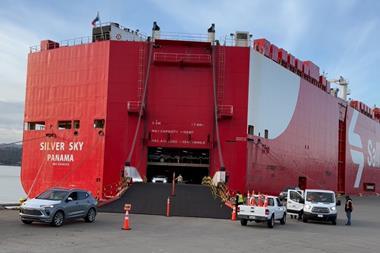 [Updated March 11th] India’s Ministry of Transport is on the verge of passing a new ruling that would make the maximum standard length for car transporters on the country’s roads 18.75 metres. In a letter seen by Automotive Logistics this week, Abhay Damle, joint secretary of the Indian government's Ministry of Road Transport and Highways, states that a draft notification has been approved establishing the standard of semi-articulated car carriers in the country at that length. Car carriers will also now have a peed limiting device installed that will restrict them to 60km per hour and be fitted with a camera at the end of the vehicle.
[Updated March 11th] India’s Ministry of Transport is on the verge of passing a new ruling that would make the maximum standard length for car transporters on the country’s roads 18.75 metres. In a letter seen by Automotive Logistics this week, Abhay Damle, joint secretary of the Indian government's Ministry of Road Transport and Highways, states that a draft notification has been approved establishing the standard of semi-articulated car carriers in the country at that length. Car carriers will also now have a peed limiting device installed that will restrict them to 60km per hour and be fitted with a camera at the end of the vehicle.
The draft notification must now be vetted by the Law Ministry.
There have previously been conflicting rules governing the standard of equipment across India’s states, with lengths that have varied as much as quality and safety. That has led to car carriers anything between 18 metres and 23 metres long, with the majority of trucks more than 22 metres long.
India’s Central Motor Vehicle Regulations (CMVR) had officially stated that any car carrier longer than 18 metres was technically illegal, though that length was regularly surpassed by vehicle carriers on the road. While executives at logistics providers generally accept 18.75 metres as a useable standard, longer trucks have been used with different drawback varieties. This disparity led to the licensing government in the state of Haryana, where 80% of equipment is made, to stop issuing certificates to car carriers last year.
The 18.75-metre length will limit the transporters to carrying eight cars, which translates as a 25% reduction in the number of cars carried compared to the longer trucks. It could also mean a rise in costs of more than 20%.
The new standard, which had been expected by carmakers since last year, will pose challenges for India’s car carriers. Speaking at the Automotive Logistics India conference in Delhi in December last year, Vipul Nanda, from carrier Mercurio Pallia and also from India’s newly formed Car Carriers Association (CCA), said the new standard would require heavy investment from carriers, and that there was a high risk that transport providers would not be able to meet the costs without recognition from the OEMs and LSPs.
There are no details available as yet as to what period of transition would be allowed for Indian carriers to harmonise their fleets with the new standard, however most of the current fleet is believed to be longer than the proposed new standard. The prevalence of the longer length appears so widespread that at least one car carrier builder at the Automotive Logistics India conference in 2014 admitted that it hardly sold any trailers for four years until it finally started building the 22-metre equipment that is technically illegal. “Now we have plenty of orders,” he said.
Nevertheless, Nanda advocated car carrier operators, logistics providers and carmakers to follow new regulations closely when introduced. “They should then discipline themselves to follow the government rules,” he continued. “We have landed in this situation because all stakeholders have jointly to be blamed for the current design. When it is implemented OEMs should discourage what is illegal and only use legal trucks.”
Executives from carmakers and logistics providers have said for some years that the expected would make rail and multimodal transport more important. Indian Railways has ambitions to increase its share of rail distribution from just 4% currently to more than 20% over the next decade. It recently opened a multi-user hub in Chennai.
A year of car carrier rulingsThe latest development in India follows the news that a new standard on trailer lengths is due to be finalised in China this year. China categorises car carriers as semitrailers, which should have a maximum length of 16.5 metres. In practice, however, car-carrying semi-trailers usually extend to 22 metres and longer trailers at 27-metres are regularly used, often with double trailers hauling two rows with as many as 25-30 cars on them.
However, according to Chris Zuo, general secretary of the China Automotive Logistics Association (CALA) of the Chinese Federation of Logistics and Purchasing (CFLP), the revised regulation will for the first time introduce centre-axle trailers as a new option for car transport on road, as opposed to the semitrailers exclusively in operation today. The new limit is set to be 22 metres in the length (with a limit of 12 metres on the trailer part).
It also follows recent legislation introduced in the US now accommodates stinger-steered automobile transporters with a vehicle length limitation of 75ft (22.8 metres) on a stinger steered automobile transporter. Now with a front overhang allowance of 4ft and a rear overhang allowance of 6ft, making a total of 85ft. The ruling was brought in as part of the Surface Transportation Reauthorisation and Reform Act of 2015 on which was signed off at the beginning of December last year.
Stinger-steered vehicles are those with the coupling device on the power unit located behind the last drive axle. The legislation does not allow for an overhang on highmount carriers with an overall length of 75ft (though highmounts that are 65ft in overall length can run with a 3ft front overhang and 4ft at the back). Highmount car carriers are fixed truck trailer units.



































